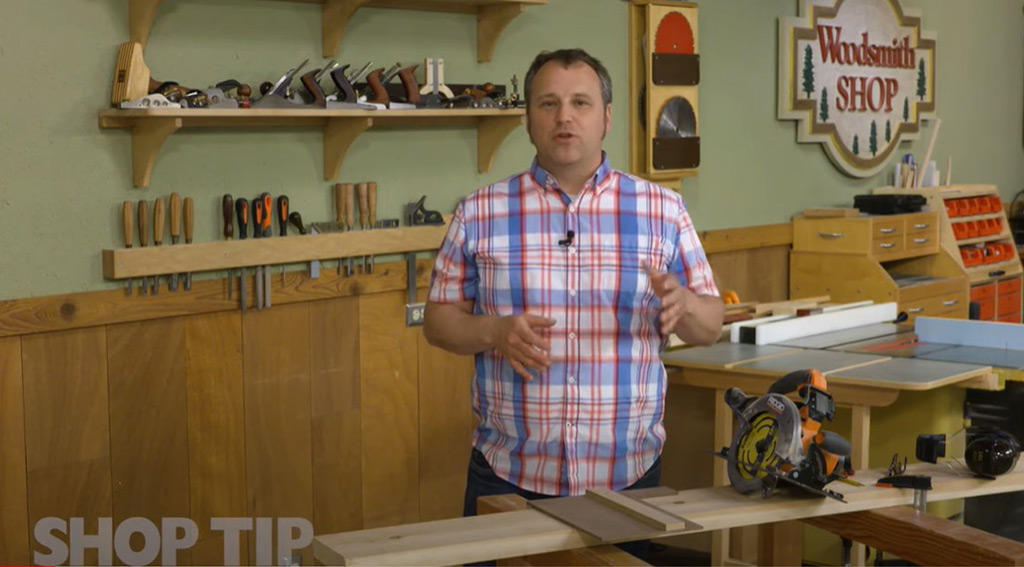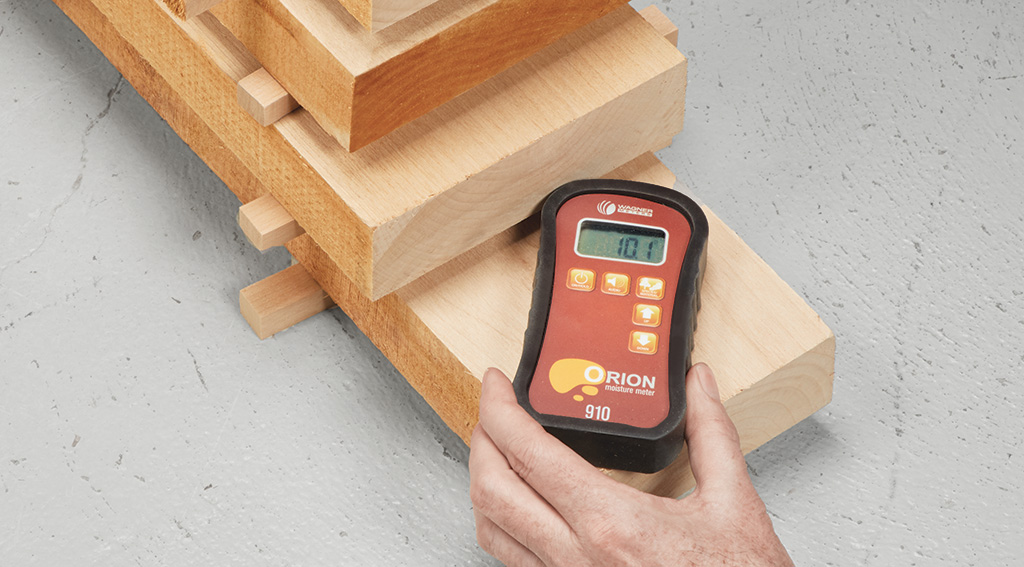
In my experience, most of the problems that arise with a wood project are due to moisture, in one way or another. Moisture causes expansion and contraction. It can also lead to finishing issues, along with general movement and warpage.
With that in mind, it amazes me how few woodworkers own a moisture meter and check their stock before beginning a project. A moisture meter, in simple terms, reads how much moisture is present in the wood. Even a difference of a few percentage points in moisture can cause issues during building. Ensuring that your wood is at the correct moisture content helps get your projects off on the right foot. So here, I want to take a look at a couple of different types of moisture meters, and explain the benefits of each.
PIN METER
In the world of moisture meters, you’ll find two styles — pin and pinless meters. Pin meters tend to come in at a lower cost (however, there are high-end models) and are often easier to find.

RESISTANCE IS FUTILE. Pin meters, like you see at right, have a pair of pins. The pins look like small nails and are usually 1⁄4" or 3⁄8" long. Pin meters work by pushing the pins into the wood. Then current is passed through the pins and the resistance is measured between them.
One of the most common brands is the General moisture meter. This is actually the first meter I purchased. The thing I really like about this meter is that it’s cheap. I paid less than $30 for this model, and for the money, it has some decent uses. But first, let’s talk about some of the drawbacks to a pin meter.
LITTLE HOLES. With a pin meter, you have to push or pound the pins into the wood to get a reading. That means that you’re left with two little holes that you’ll have to deal with. Second, the pins only take a reading where they touch the wood. So, if you want to check the moisture in a thick board, you’ll need to cut into it to take a measurement.
Another downside with pin meters is what they read, which is resistance. Resistance is easy to measure, but it can easily be skewed by a tree’s chemical make-up. If a tree grew in an area with a high concentration of minerals, it could cause the wood to be more, or less, conductive, which skews a resistance reading. Frozen stock (such as lumber drying outside) will not give an accurate reading either.
DISPOSABLE. I prefer inexpensive pin meters like this for less-demanding tasks, such as measuring firewood or framing lumber. Plus, if it gets dropped and damaged, it’s not a huge deal. While this grade of meter is better than no meter, you may want something more accurate for measuring stock in your shop.
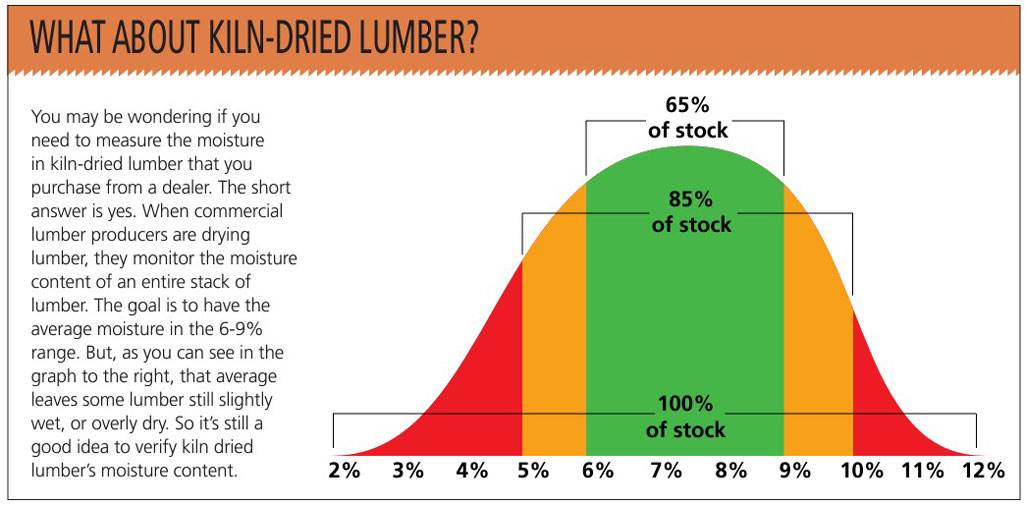
PINLESS METERS
In contrast to their pinned cousins, pinless meters do not have pins to measure moisture. Instead, they rely on taking a reading through a sensor pad that is usually located on the back of the meter.
They measure moisture by transmitting an electromagnetic wave and then reading the electrical impedance within the magnetic field. This is done by setting the moisture meter to the specific density of the wood you’re measuring.
MY PREFERRED METER. Pinless (sometimes called scanning) meters are available in a wide range of price points. They are my preferred style for taking moisture readings for a couple of reasons.
First, I find that they tend to be more accurate. The chemical composition of the tree doesn’t affect the moisture reading, and higher end models compensate for temperature as well.
Second, I find they’re faster to use. You can even use them on a finished piece of furniture without leaving telltale pin holes.

DR. METER. My first scanning meter was the Dr. Meter. It runs about $50 and has 10 programmed settings for different wood species.
ACCURACY. Dr. Meter claims that their scanning model will measure moisture content between 4-80%, with a variance of +/-1.5%. The meter comes with a carrying case as well as a reference chart for the preset densities.
The Dr. Meter is a passable moisture meter for most woodworking needs. However, with only 10 preset densities, there’s quite a bit of room for inaccuracy. Not to fear, there are more accurate meters available.
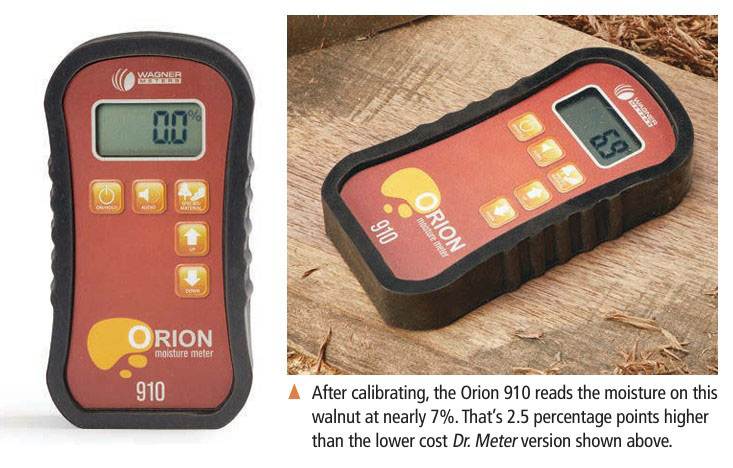
WAGNER’S ORION LINE. Wagner has long been a respected name in the moisture meter industry. Two of their most popular models are shown here — the Orion 910 and the professional-grade Orion 950. When I started digging into the Orion line of moisture meters, I discovered some features that I really found useful.
CALIBRATION. All of the Orion line of meters come in a plastic carrying case, equipped with a calibration platform. This high-density plastic platform basically allows you to zero out your meter to achieve an accurate reading every time.
In addition to calibration, the Orion line of meters compensates for ambient air temperature and moisture and can be set for densities ranging from a specific gravity of .2 up to 1. This means you’ll get an accurate reading for every species from balsa to lignum vitae.
THE 910. Wagner’s consumer-grade meter, the 910, reads moisture up to a depth of 3⁄4". The 910 also features what Wagner calls IntelliSense technology. In short, this allows the meter to ignore light surface moisture and measure deeper in the wood. This means a piece of wood that was just rained on won’t give a false reading because of the surface moisture. (It may read a touch higher, but not drastically like other meters).
For every day workshop needs, the 910 fits the bill perfectly. It’s more expensive than other models, coming in at about $379, but you’re paying for accuracy.
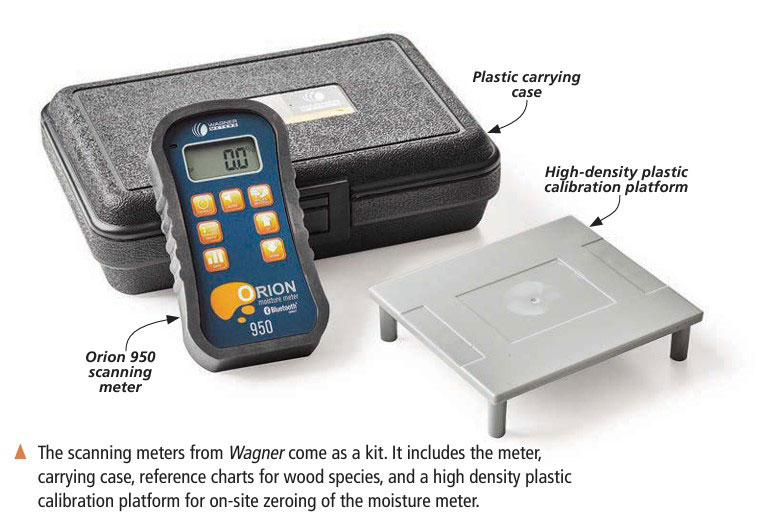
PROFESSIONAL GRADE 950. If you want just a little more from your meter, the next step up from the 910 is the Orion 950. It’s a professional-grade meter that can read two different depths — 1⁄4" and 3⁄4". Not only does it have all the functions that the 910 has, but it has a few more bells and whistles that the tech nerd in me loves.
BLUETOOTH. You read that right — the 950 is bluetooth enabled to hook up with a smart phone. This means that the 950 can take measurements and chart moisture over an extended period of time. This isn’t something that most of us would use every day, but if you’re drying lumber on a large scale, or like to provide documentation to clients on the material you use when building furniture, it’s valuable.
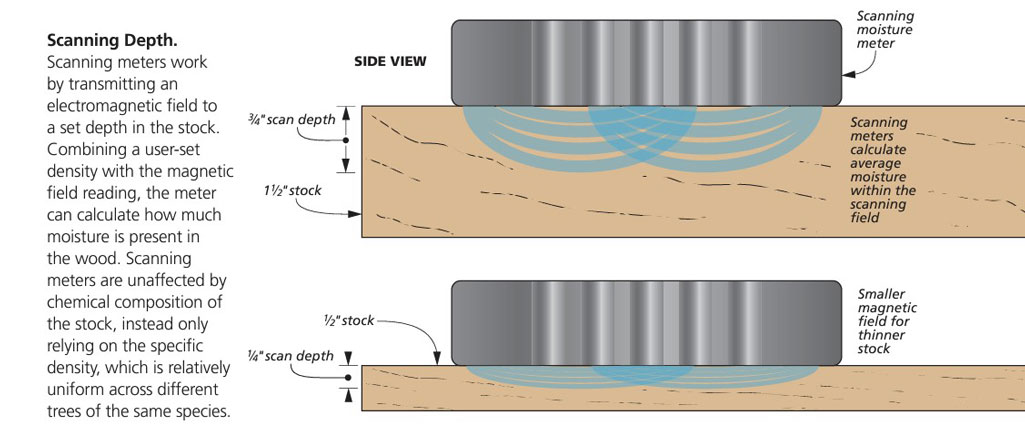
EQUILIBRIUM MOISTURE CONTENT. As much as I like the bluetooth feature, there’s one single feature of the 950 that would push me to make the investment and purchase one. And that is the equilibrium moisture content mode. In this mode, the 950 will measure the temperature and moisture in a room and calculate at what moisture percentage a piece of stock will stabilize at. This allows you to know when a board has fully acclimated to its environment, and won’t continue to lose or gain moisture.
MOISTURE METERS IN YOUR SHOP. Moisture meters may not be the big, cool tool that everyone dreams of when they’re planning purchases for their shop. However, a quality project starts with the material that you’re using. And making sure that stock is dry, acclimated, and ready to use lays an important foundation for you to be successful.
So, if you don’t have a moisture meter on hand, use this information to select one that suits your needs.












